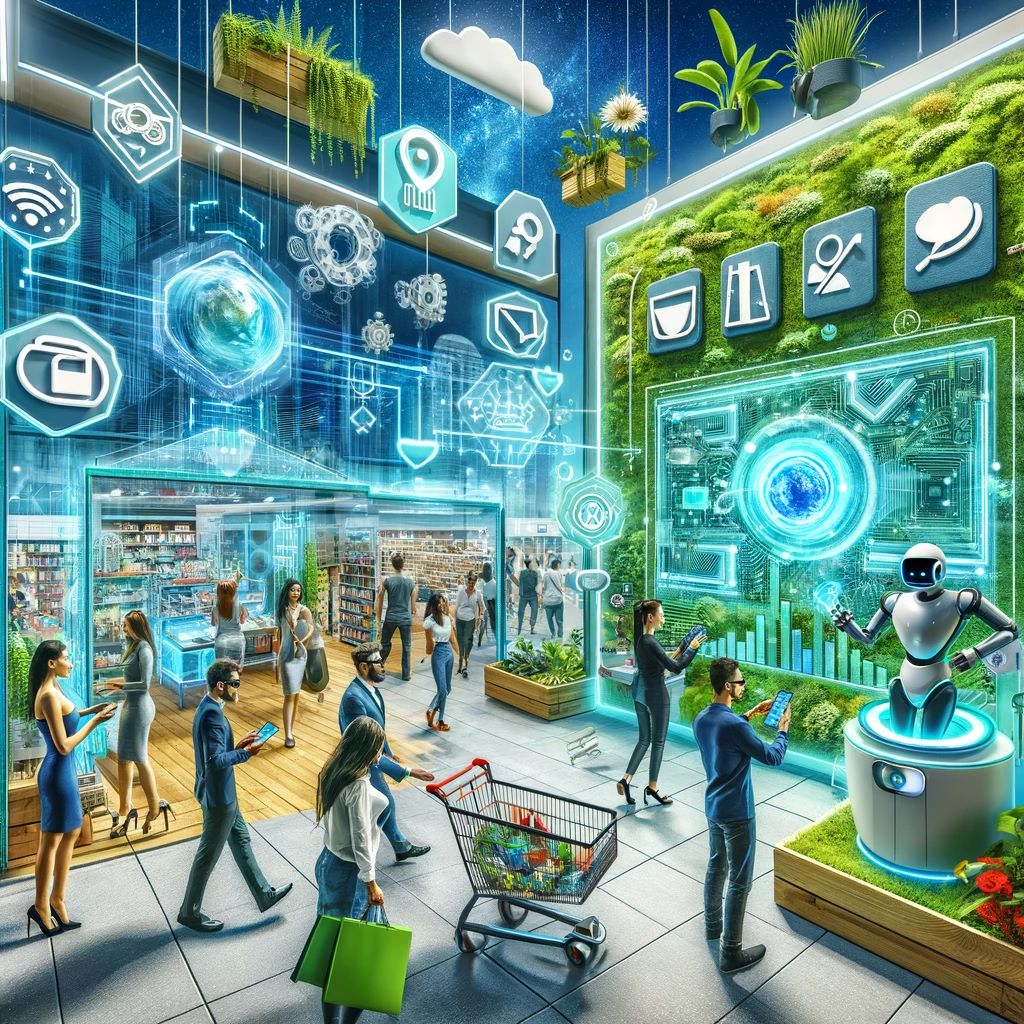
And What You Can Do to Improve Awareness:
Sustainability and Eco-Friendly Practices:
Focus on how retail can become more sustainable, from supply chain to packaging.
Writing about and implementing eco-friendly practices could appeal to a growing demographic concerned about the environment.
Technology Integration:
Explore cutting-edge technologies like AI for customer behavior prediction, VR for virtual try-ons, or blockchain for supply chain transparency.
Being at the forefront of tech application in retail can set you apart.
Personalization and Customization:
Delve into strategies for highly personalized customer experiences. Use data analytics to understand customer preferences and tailor your offerings accordingly.
Local Community Engagement:
Create content about building local partnerships, supporting community events, or showcasing local products.
This grassroots approach can create a loyal customer base.
Retail Health and Wellness Integration:
With an increased focus on health, integrating wellness aspects into retail (like health-conscious product lines or in-store wellness experiences) can capture a growing market segment.
Experiential Retail:
Explore how to transform shopping from a transaction to an experience. Think about workshops, pop-up events, or in-store experiences that are unique and shareable.
Ethical Sourcing and Fair Trade Practices:
Write about and implement ethical sourcing practices. This resonates with consumers who are increasingly conscious about where and how products are made.
Omnichannel Strategies:
Investigate the integration of online and offline experiences, ensuring a seamless customer journey.
This includes social media integration, mobile shopping experiences, and more.
Retail Analytics and Big Data:
Utilize big data to understand market trends, customer behavior, and inventory management. Writing about practical applications of data in retail can be valuable.
Niche Market Penetration:
Identify and write about untapped market segments or niche areas within retail. This could include specialized products, services, or customer groups.
- Identifying Untapped Markets: Research to discover underserved or overlooked market segments. For instance, eco-conscious consumers or people with specific hobbies.
-
Underserved Market Segments in the Beauty Industry:
- Non-White and Multiracial Beauty Shoppers:
- Demographic: Significant portion of the US population.
- Opportunity: Design products and communications for diverse racial profiles.
- Example: Black beauty shoppers are avid consumers but have unmet needs, especially in fragrance purchases.
- Hispanic and Latino Beauty Shoppers:
- Demographic: The largest minority market in the US, with growing spending power.
- Opportunity: Cater to their varied beauty needs and preferences.
- Example: This segment’s buying power grew to $1.9 trillion in 2020.
- Male Beauty Shoppers:
- Demographic: Increasingly using beauty products for self-expression and self-care.
- Opportunity: Expand beyond traditional grooming to cosmetics and advanced hair/beard care.
- Example: Social norms are changing, with Gen Zers accepting male cosmetics use.
- 50+ Female Beauty Shoppers:
- Demographic: Women over 50 with greater discretionary income.
- Opportunity: Address their specific beauty needs, often overlooked in favor of younger consumers.
- Adaptive Beauty Shoppers:
- Demographic: Consumers requiring assistive technologies.
- Opportunity: Tech-enabled beauty tools can drive increased product use and enjoyment.
- Non-White and Multiracial Beauty Shoppers:
- Specialized Products or Services: Develop or source products/services catering specifically to these niche markets. An example is catering to pet owners with a range of organic pet foods.
- Targeted Marketing Strategies: Tailor your marketing efforts to speak directly to the niche market. This could involve using specific social media platforms or collaboration with influencers in that niche.
- Customized Customer Experience: Create a shopping experience that resonates with the niche market. For instance, a store focusing on sustainable living might host educational events on eco-friendly practices.
- Community Building: Build a community around your niche market, fostering a sense of belonging and loyalty. This can be achieved through online forums, social media groups, or in-store events.
Neuroscience in Retail:
Delve into how neuroscience can influence retail strategies, such as store layout, music, and scent marketing.
This area is often underexplored but can significantly impact consumer behavior.
Neuroscience in Retail: Unlocking the Brain’s Role in Shopping Behavior
Introduction The retail landscape is evolving rapidly, with new technologies and strategies reshaping how consumers shop. Among these innovations, neuroscience stands out as a groundbreaking approach to understanding and influencing customer behavior. This article delves into how neuroscience is being integrated into retail strategies, offering insights into the human brain’s role in shopping decisions.
Understanding the Consumer’s Brain Neuroscience in retail, often referred to as ‘neuromarketing’, applies knowledge about the brain’s functioning to marketing and retail strategies. It involves studying how different stimuli – like colors, scents, and layouts – trigger emotional and neurological responses in shoppers, influencing their purchasing decisions.
Sensory Marketing: Tapping into the Senses One of the key aspects of neuroscience in retail is sensory marketing. Retailers use sensory cues to create an appealing shopping environment. For example, the scent of fresh bread in a grocery store can evoke a sense of warmth and comfort, encouraging purchases. Similarly, the right color combinations can affect mood and perception, leading to increased engagement with products.
The Role of Emotions in Purchasing Decisions Neuroscience reveals that emotions play a significant role in shopping. Positive emotional experiences can lead to brand loyalty and repeat purchases. Retailers are now using emotional triggers to enhance customer experience, such as creating a sense of excitement or urgency through limited-time offers.
Personalization Through Neuroscience Advancements in neuroscience have enabled retailers to personalize shopping experiences. By analyzing brain responses, retailers can tailor product recommendations and advertisements to individual preferences and decision-making patterns.
Neuroscience and Online Shopping In the digital realm, neuroscience principles are used to optimize website design and online user experience. This includes understanding how visual elements and navigation paths affect the consumer’s decision-making process.
Ethical Considerations While neuroscience offers powerful tools for retailers, it also raises ethical questions. Retailers must balance the use of neurological insights with respect for consumer privacy and autonomy.
Conclusion Neuroscience in retail is a fascinating and rapidly evolving field. By understanding the neurological underpinnings of consumer behavior, retailers can create more engaging, satisfying, and effective shopping experiences. As this field grows, it will continue to shape the future of retail in profound ways.
Cultural Intelligence in Retail:
Focus on understanding and adapting retail strategies to diverse cultural backgrounds.
Writing about and advising on culturally intelligent practices can open doors to untapped demographics.
Augmented Reality (AR) in Retail Space Design:
Explore how AR can enhance customer experience in physical stores. Providing consultancy on AR integration can set you apart in a tech-forward market.
Behavioral Economics in Pricing Strategies:
Investigate how psychological factors affect consumer purchasing decisions. Offering insights and strategies based on behavioral economics can be a unique selling point.
Retail in the Circular Economy:
Advise on how businesses can integrate into the circular economy, focusing on sustainability and waste reduction.
This area is increasingly relevant and can attract environmentally conscious clients.
Micro-Moments Marketing:
Look into the concept of micro-moments – brief periods when consumers turn to a device to act on a need.
Advise on strategies to capitalize on these moments in retail.
Inclusive Design in Retail:
Specialize in creating retail environments that are accessible and welcoming to people with disabilities.
This area is often overlooked but can significantly enhance brand reputation and customer loyalty.
Retail Data Ethics and Privacy:
With the increasing use of consumer data, offering expertise in ethical data usage and privacy protection can be highly appealing to clients.
Supply Chain Resilience:
Focus on strategies for creating more resilient supply chains, especially in the context of global disruptions like pandemics or trade wars.
Retailtainment Strategies:
Help clients create shopping experiences that are also entertainment, leveraging the trend where shopping is not just about purchasing but an experiential journey.
Emphasizing Emotional Intelligence (EI) in Customer Service:
Develop training modules that focus on enhancing EI among retail staff. This is crucial for customer satisfaction and loyalty.
Integrating Behavioral Economics:
Offer training on how consumer behavior is influenced by psychological factors. Understanding these can lead to more effective sales strategies.
Utilizing Data Analytics in Retail Decision-Making:
Create courses that teach how to use data analytics for inventory management, customer trend analysis, and personalized marketing.
Sustainable Retail Practices:
Develop training focused on eco-friendly and sustainable practices in retail management.
Omnichannel Retail Strategies:
Offer specialized training on integrating and managing various sales channels (online, in-store, mobile) for a seamless customer experience.
Accessibility and Inclusivity in Retail:
Create programs that train retail managers and staff on creating inclusive environments for all customers, including those with disabilities.
Retail Tech Innovations:
Stay abreast of the latest retail technologies (e.g., AR/VR, IoT, AI) and incorporate them into your training programs.
Crisis Management and Resilience Training:
Given recent global events, training in crisis management and building business resilience can be highly valuable.
Ethical Sourcing and Supply Chain Transparency:
Offer training on ethical sourcing practices and supply chain transparency, which are increasingly important to consumers.
Retail Leadership and Talent Development:
Focus on developing the leadership skills of retail managers, including how to nurture talent within their teams.
Unlock Your Potential in Retail Management.
Enroll in our Retail Business Academy Today
Transform Your Career & Business!




















